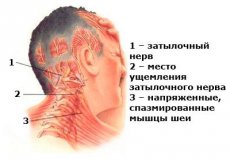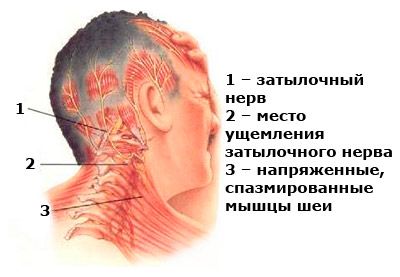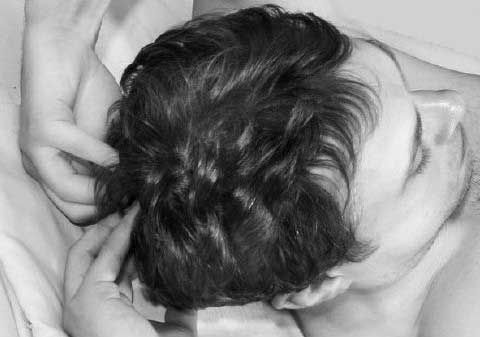Medical expert of the article
New publications
Occipital pain
Last reviewed: 04.07.2025

All iLive content is medically reviewed or fact checked to ensure as much factual accuracy as possible.
We have strict sourcing guidelines and only link to reputable media sites, academic research institutions and, whenever possible, medically peer reviewed studies. Note that the numbers in parentheses ([1], [2], etc.) are clickable links to these studies.
If you feel that any of our content is inaccurate, out-of-date, or otherwise questionable, please select it and press Ctrl + Enter.

Causes of occipital pain
Among the most common causes of pain in the back of the head is pain due to tension in the neck extensors, which are located just above the back of the head.
Pain in the back of the head can radiate to the neck, so a person may mistakenly assume that his neck hurts, not the back of the head. At the same time, any turn of the head can painfully respond with poor health and even loss of consciousness. Even touching the back of the head can be very painful.
Pain in the back of the head can also occur due to overstraining of the head or neck muscles. Occipital pain can bother a person due to injury, compressed occipital nerves or compression of the upper nerve roots, which are located in the spinal cord. The culprits of pain in the back of the head can also be the spinal ganglia and the dorsal horn - the lateral parts of the spinal cord, similar to horns, which is why they got their name.
Occipital headaches are characterized by paresthesia or increased sensitivity to pain in the scalp and neck skin. Occipital neuralgia, cervical spondylosis, myogelosis of the cervical spine, stress, mental strain, and other diseases can cause headaches in the back of the head.
 [ 3 ]
[ 3 ]
Cervical spondylosis
This is a chronic disease of the spine. In this disease, the spiky and beak-shaped sharp edges of the vertebra are deformed - osteophytes, which are located along the edges of the vertebral bodies. According to some data, osteophytes are formations that grow directly on the bone. They are called salt deposits, but this is far from true. In fact, osteophytes grow due to the degeneration of bone ligaments. In the cervical spine, a disease called spondylosis often occurs, which is associated with age-related changes in the cervical spine.
Spondylosis can bother those people who move little and do a lot of mental work, overstraining the cervical vertebrae.
Common symptoms of cervical spondylosis are back pain, shoulder pain, pain behind the head, pain in the eyes, even the ears hurt. This pain does not go away even at rest, when a person tries not to move his head. The neck also cannot move because of the pain, a person cannot turn his head.
Patients suffering from spondylosis are unable to move fully, they even find it difficult to fall asleep normally, they cannot find a normal sleeping position. The uncomfortable position of the neck muscles leads to stress on the neck joints and cervical ligaments, as well as on the entire spine as a whole.
Spondylosis is characterized by long-term pain in the spine, in the neck area, head movement is difficult. When a doctor examines patients, he immediately finds that the movement of the neck vertebrae is difficult, the neck does not turn. As soon as you press on the back of the joint between the vertebrae, a person feels severe pain, especially when tilting the head back. Pain in spondylosis does not go away immediately, it lasts for quite a long time.
 [ 4 ], [ 5 ], [ 6 ], [ 7 ], [ 8 ]
[ 4 ], [ 5 ], [ 6 ], [ 7 ], [ 8 ]
Myogelosis of the cervical spine
This condition is characterized by a greater density of the neck muscles than usual, accompanied by severe occipital pain.
Among the most common causes of myogelosis are:
- Frequent and prolonged stay in an uncomfortable position
- Frequent drafts
- Bad posture
- Nerve tension, stressful situations
- Myogelosis of the muscles of the cervical spine can be determined by the following symptoms:
- Pain in the back of the head
- Shoulder pain and limited shoulder movement
- I often feel dizzy
- Nerve tension that occurs after severe stress, chronic or acute
- Overexertion from exercise, overexertion from working at a computer or driving
Women are most often at risk of suffering from myogelosis, as they are most often engaged in small routine work. The peak of the disease is 30 years, and at this age, occipital pain tends to intensify more and more often.
Occipital neuralgia

Occipital neuralgia is pain due to inflammation or compression of the greater occipital nerve as it exits between the back of the head and the first cervical vertebra.
As a rule, the pain with this disease is given to the eye area, but may include irradiation to the occipital region. Occipital pain is usually quite acute.
Occipital neuralgia is a neurological condition in which the occipital nerves, which run from the top of the spinal cord at the base of the neck up through the scalp, become inflamed. Occipital neuralgia can be confused with migraines or other types of headaches because the symptoms can be similar. But occipital neuralgia is a separate disorder that requires an accurate diagnosis and proper treatment.
Symptoms of occipital neuralgia
Occipital neuralgia can cause very intense pain that feels like a sharp, electric shock-like sensation in the back of the head and neck. Other symptoms of occipital neuralgia may include:
- Pain, burning and throbbing pain that usually starts at the base of the head and radiates to the scalp
- Pain on one or both sides of the head
- Pain in the area behind the eyes
- Severe sensitivity to light
- Discomfort and pain in the scalp
- Pain when moving the neck
Causes of occipital neuralgia
Occipital neuralgia is the result of compression or irritation of the occipital nerves due to injury, nerve entrapment, or inflammation. The exact causes of occipital neuralgia have not yet been found.
There are many medical conditions that are associated with occipital neuralgia, including:
- Occipital trauma
- Neck and/or neck muscle tension
- Osteoarthritis
- Neck tumor
- Cervical Disc Diseases
- Infection
- Gout
- Diabetes
- Inflammation of blood vessels
Diagnosis of occipital neuralgia
If you think you have occipital neuralgia, make an appointment with your doctor. Your doctor will ask questions about your medical history and any recent injuries you've had.
For a more accurate diagnosis, your doctor may order a complete blood count and an MRI. Your doctor may also order a cervical nerve block to see if it relieves the pain. If it does, the cause of the pain is likely occipital neuralgia.
Treatment of occipital neuralgia
Treatment for occipital pain due to this condition depends on what exactly is causing the inflammation or irritation of the occipital nerves. There are a number of things you can try to relieve occipital pain, including:
- Applying heat to the neck.
- Relax in a quiet room.
- Massage of stiff and painful neck muscles.
- Try anti-inflammatory medications such as naproxen or ibuprofen
- If these pain relief measures don't work, your doctor may prescribe the following medications to treat occipital neuralgia:
- Muscle relaxants
- Anticonvulsants
- Antidepressants
- Short-term neck blocks and steroid injections
Surgical intervention may include the following:
Microvascular decompression: During this procedure, your doctor can reduce pain by identifying and correcting blood vessels that may be causing nerve compression.
Occipital nerve stimulation. In this procedure, a neurostimulator is used to deliver electrical impulses to the occipital nerves. These electrical impulses can help block pain signals sent to the brain.
Occipital neuralgia is not a life-threatening condition. Most people get significant pain relief from rest and pain medication. However, if you do not get relief and continue to experience pain in the back of your head and neck, talk to your doctor. The pain may be caused by another condition you did not even know about.
What are the symptoms of occipital headache?
Distinguishing between occipital headaches and other forms of headache can be difficult because of the significant overlap in symptoms. Occipital pain is usually located in the part of the neck where many occipital nerves pass. The inflamed nerves respond immediately to palpation.
Who should you contact if you have occipital pain?
Occipital pain is a symptom that should not be ignored. At least so that this pain does not worsen and does not lead to complete loss of ability to work. A neurologist and therapist can help diagnose and treat occipital pain.


